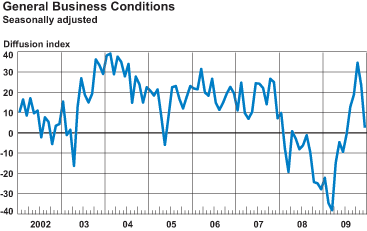December 2009 Report
Survey Indicators
Seasonally Adjusted

The Empire State Manufacturing Survey indicates that conditions for New York manufacturers leveled off in December, following four months of improvement. The general business conditions index fell 21 points, to 2.6. The indexes for new orders and shipments posted somewhat more moderate declines but also moved close to zero. Input prices picked up a bit, as the prices paid index rebounded to roughly its November level; however, the prices received index moved further into negative territory, suggesting that price increases are not being passed along. Current employment indexes slipped back into negative territory. Future indexes remained well above zero but signaled somewhat less widespread optimism than in recent months. Indexes for expected prices paid and received declined moderately but remained well above zero.
In a series of supplementary questions (see Supplemental Reports tab), manufacturers were asked about recent and expected changes in the prices paid for various categories of goods and services. Respondents predicted that prices paid for most budget categories would increase by 2 to 3 percentage points more in 2010 than in 2009. Prices paid overall were reported to have risen by 2.5 percent in 2009 and were expected to rise by 4.2 percent next year. The average respondent anticipated an increase of 2.1 percent in both wages and costs of outside services, 7.6 percent in employee benefit costs, and 3.5 percent in nonmedical insurance costs. In response to a separate question, the average respondent saw a roughly 7 percent chance that prices paid would decline by more than 2 percent; in last year’s survey, the probability of such a decline was pegged at 19 percent.
Conditions Level Off
The general business conditions index fell from 23.5 to just 2.6, suggesting a leveling off in conditions after four straight months of improvement. Roughly 24 percent of those surveyed in December said that conditions had improved, while 22 percent reported that conditions had deteriorated. Most of the other specific activity measures fell a bit less sharply: the new orders index slipped more than 14 points to 2.2, and the shipments measure declined by just under 7 points to 6.3. The unfilled orders index fell by more than 18 points to -21.1, its lowest level in nine months. In contrast, the index for delivery times held steady at -2.6, and the inventories index, at -18.4, was little changed for the third straight month.
Manufacturers See Margins Squeezed Survey respondents faced somewhat higher input prices in December, while their selling prices declined. The prices paid index rose 9 points to 19.7, reversing a drop of similar magnitude in November and suggesting some renewed price pressures. At the same time, the prices received index slipped 6.6 points to -9.2, its lowest level since August. Employment indexes declined for the second straight month, falling below zero for the first time in a few months: the index for number of employees slipped 7 points to -5.3, and the average workweek index fell 11 points to -5.3.
Manufacturers’ Optimism Ebbs Slightly; Prices Are Expected to Rise
Manufacturers remained generally optimistic about the outlook for general business conditions and activity, although a bit less so than in recent months. After rising to its highest level in more than a year, the index for expected general business conditions retreated 14 points to 43.0—still a high level but the lowest since July. The forward-looking indexes for both new orders and shipments fell by almost as much but remained in the upper 30s, while the future unfilled orders index declined by a more moderate 5 points to 12.0. The index for expected delivery times edged up to zero, its highest level in more than a year, and the measure for future inventories was unchanged at 7.9.
Forward-looking price indexes declined in December, after rising sharply in the preceding month: the index for future prices paid slipped nearly 8 points to 40.8, and the index for future prices received dropped about 5 points to 22.4. The index for expected number of employees reversed course in December, retreating 13 points to 17.8, while the future average workweek index was little changed at 19.7. The measure for planned capital expenditures jumped more than 9 points to 30.3, its highest level since May 2007; however, the measure for planned technology spending edged down to 13.2.










